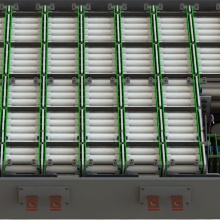Modern Li-ion battery cells, such as are used in electric cars among other things, are not static objects like screws or nails. They behave much more dynamically when in use, and change dimensions at the atomic level when being charged or discharged due to chemical-physical properties. The same happens when the batteries age, because irreversible changes occur to the material structure of electrodes which lead to a change in the thickness of the entire battery.
This means that it is not possible to be exact about the dimensions of batteries – something which is a real nuisance to design engineers. On the other hand, this dynamic is a gift for the “Electrical Energy Storage Systems” research group (led by Prof. Kai Peter Birke) at the Institute for Photovoltaics at the University of Stuttgart. As part of the “battery sensor” project, they are attempting to measure the fluctuations in volume in order to be able to deduce important battery state variables such as the charging level, the aging and the performance – measures which without having this information at all times make it impossible to operate an electric vehicle safely.
The project is pursuing a number of objectives. “Firstly we want to develop a robust mechanical arrangement for measuring strain”, explains Jessica Hemmerling, research assistant at the IPV and project coordinator. “Secondly, we are using artificial intelligence specifically to be able to infer the battery state from highly complex reversible and irreversible changes in the thickness of cylindrical cells.
Surfaces like a potato
The project has already yielded important new findings about localized and unexpected changes in thickness. “As a matter of fact, over time cells can assume shapes which when magnified actually look like the surface of a potato”, says Hemmerling. If multiple cells are densely packed together in so-called battery modules, these fluctuations in thickness can definitely become a problem. This is because when a cell expands it exerts pressure on the surrounding cells, which can quickly lead to them aging or even failing entirely.
Localized fluctuations in thickness and an understanding of them therefore are extremely important for the future design of cells or cell modules – completely in keeping with the University of Stuttgart's mission statement of “Intelligent Systems for a Sustainable Society”.
About the “battery sensor” project
The battery sensor project receives around EUR 190,000 in funding from the German Federal Ministry for Economic Affairs and Energy (BMWi) via the German Federation of Industrial Research Associations (AiF) over a period of 2.5 years (grant number ZF4370703LT9). The project partners include the companies scemtec Sensor Technology GmbH, Ansmann AG and birkle IT AG.
Contact:
Prof. Dr. Kai Peter Birke, Jessica Hemmerling, University of Stuttgart, Institute for Photovoltaics, Electrical Energy Storage Systems group, tel. +49 711 685-67180 e-mail Prof. Birke, e-mail Jessica Hemmerling


